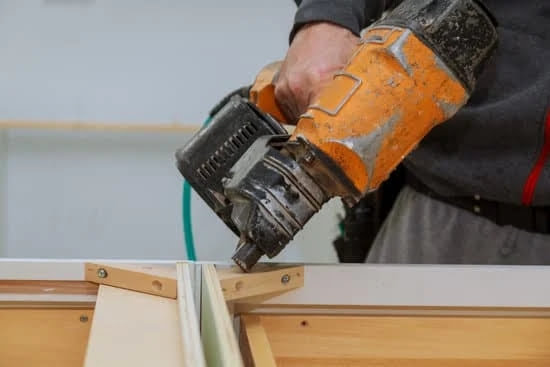Woodworking is a timeless craft that requires precision, skill, and the right tools. One essential tool that every woodworker needs in their arsenal is a chisel set. A chisel set is a collection of various sizes and types of chisels designed specifically for woodworking tasks. These versatile tools are used to shape, cut, carve, and remove material from wood, making them indispensable for any woodworking project.
Chisel sets come in different shapes and sizes, each designed for specific purposes in woodworking. They consist of a sharp cutting edge attached to a handle made of wood or plastic for easy handling. The cutting edges can be straight or have different profiles such as angled or curved, allowing woodworkers to achieve precise cuts and intricate designs.
In woodworking, chisel sets find numerous applications across various tasks. From shaping intricate details to cleaning joints or creating mortises and tenons, chisels are essential for achieving clean and professional finishes. Whether you are a beginner or an experienced woodworker, understanding the uses and techniques of chisels is crucial for mastering this craft.
In the following sections of this article, we will delve deeper into the world of chisel sets in woodworking. We will explore the different types of chisels available, common uses for these tools, techniques for using them effectively, maintenance and care guidelines, safety precautions to follow when working with chisels, recommended chisel sets based on specific projects, and finally summarize why these tools are vital for any woodworker’s toolkit.
So let’s begin our journey into the fascinating realm of woodworking with chisels.
What are chisel sets? Overview of the basic components and types available
A chisel set is a collection of chisels that are used in woodworking for carving, shaping, and cutting wood. Chisel sets typically consist of several different types and sizes of chisels, each designed for specific tasks and applications. These tools are an essential part of any woodworker’s toolkit due to their versatility and precision.
The basic components of a chisel set include the blade, handle, and ferrule. The blade is the metal part of the chisel that does the actual cutting and shaping. It is usually made from high-quality steel that can hold a sharp edge.
The handle provides grip and control while using the chisel, allowing the user to guide the tool accurately. Handles are commonly made from wood or plastic. The ferrule is a metal ring or collar that reinforces the connection between the blade and handle, providing strength and stability.
There are various types of chisels available in a chisel set, each designed for specific woodworking tasks. Some common types include bench chisels, mortise chisels, paring chisels, dovetail chisels, and carving gouges. Bench chisels are versatile and suitable for general woodworking tasks such as cutting joints or cleaning up rough surfaces. Mortise chisels have thicker blades and are used for creating rectangular holes called mortises. Paring chisels have long, thin blades used for delicate shaving or trimming tasks.
| Type | Description |
|---|---|
| Bench Chisel | Versatile all-purpose chisel suitable for general woodworking tasks. |
| Mortise Chisel | Thicker blade specifically designed for creating mortises. |
| Paring Chisel | Long, thin blade used for delicate shaving or trimming tasks. |
| Dovetail Chisel | Narrow-bladed chisel used for cutting dovetail joints. |
| Carving Gouge | Curved blade for carving and shaping wood. |
Having a variety of chisels in a set allows woodworkers to choose the most suitable tool for each specific task. Whether it’s creating joints, shaping intricate details, or removing material, chisels are an indispensable part of the woodworking process. Understanding the different components and types of chisels available is essential when building a woodworking toolkit.
Common uses of chisel sets in woodworking
Chisel sets are an essential tool in woodworking, allowing craftsmen to achieve precise and detailed work. Whether you’re a beginner or an experienced woodworker, understanding the various tasks that can be accomplished using chisels is crucial. In this section, we will detail the common uses of chisel sets in woodworking and explore the different tasks that can be accomplished with these versatile tools.
Shaping and Carving
One of the primary uses of chisels in woodworking is shaping and carving wood. Chisels allow craftsmen to remove excess material, creating smooth edges and intricate designs. They are commonly used for sculpting and shaping curved surfaces such as chair legs, intricate patterns on furniture, or decorative elements on cabinetry.
Mortising and Joinery
Chisels play a vital role in mortising and joinery tasks in woodworking. Mortising refers to creating a rectangular hole or recess in wood to accommodate tenons or dowels for joining pieces together. Chisels are used to precisely cut out these recesses, ensuring a snug fit for strong joints. Additionally, chisels are essential for clean cuts when working with dovetail joints, where they help shape and remove material for tight-fitting joints.
Cleaning Up Joints
Another common use of chisel sets is cleaning up joints after they have been formed. Woodworking often involves joining multiple pieces together using techniques like dovetailing, box joints, or dado joints. After these joints have been assembled, there may be excess material or rough edges that need to be trimmed or smoothed out for a clean finish. Chisels allow craftsmen to remove excess wood precisely while maintaining control over the final result.
Overall, chisel sets offer unparalleled versatility when it comes to performing various woodworking tasks with precision and detail. From shaping and carving wood to mortising, joinery, and cleaning up joints, chisels are an indispensable tool for any woodworker. In the next section, we will highlight the specific chisels that beginners should consider owning in their woodworking toolkit.
Essential chisels for a beginner’s woodworking toolkit
Chisels are an essential tool for any woodworker, and having a good set of chisels is crucial for getting started in woodworking. For beginners, it can be overwhelming to choose the right chisel set with so many options available. In this section, we will highlight the specific chisels that beginners should consider owning to build their woodworking toolkit.
- Beveled edge bench chisel: This is one of the most commonly used chisels in woodworking. It has a flat back and a beveled cutting edge, making it great for general-purpose tasks like chopping out waste material, paring joints, or creating clean lines. A set of beveled edge bench chisels with different sizes ranging from ¼ inch to 1 inch would be ideal for most beginner projects.
- Mortise chisel: If you plan on doing joinery work such as mortise and tenon joints, a mortise chisel is a must-have. It has a thicker blade and stronger construction compared to bench chisels to withstand the heavier mallet blows required for cutting mortises. A ¼ inch or ½ inch mortise chisel should suffice for most beginner projects.
- Firmer or butt chisel: These chisels have a shorter blade length and are excellent for precise work in tight spaces or corners. They are also useful when working with small-scale projects or fine detailing work. Having a ⅛ inch or ¼ inch firmer chisel as part of your toolkit will offer more flexibility in your woodworking endeavors.
- Skew chisel: Skew chisels have angled cutting edges that make them suitable for trimming and shaping dadoes, rabbets, tenons, and other angled cuts. They can also be used for decorative carving work or smoothing out curved surfaces. Adding a skew chisel with about ⅜ inch size to your collection will broaden your woodworking capabilities.
By starting with these essential chisels, beginners will have a versatile set that can handle most woodworking tasks. As you progress and gain more experience, you may want to expand your collection to include specialty chisels for specific projects or techniques. It’s important to invest in high-quality chisels that will last and stay sharp longer, ensuring the best results in your woodworking projects.
| Chisel Type | Size (inch) |
|---|---|
| Beveled edge bench chisel | ¼ – 1 |
| Mortise chisel | ¼ – ½ |
| Firmer or butt chisel | ⅛ – ¼ |
| Skew chisel | ⅜ |
Techniques for using chisel sets effectively
Basic Techniques for Using Chisel Sets
Using chisel sets effectively is crucial for achieving precise and clean cuts in woodworking. Whether you are a beginner or an experienced woodworker, mastering the following basic techniques can greatly enhance your woodworking skills.
Holding and Gripping the Chisel
When using a chisel, it is essential to hold it correctly to ensure control and accuracy. Firmly grasp the chisel handle with your dominant hand, keeping your fingers wrapped around the handle for stability. Place your other hand on top of the chisel blade or rest it against the side of the blade for additional control. Maintain a balanced grip between both hands to have better precision.
Marking and Preparing Your Workpiece
Before you begin using a chisel, it is important to mark outlines or guidelines on your workpiece to indicate where you want to make your cuts. This helps in achieving accurate results and prevents any accidental slips or mistakes. Use a pencil or a marking gauge to make clear and visible markings on the surface of the wood.
Starting Cuts with a Mallet or Hammer
For certain tasks that require heavier cuts or removal of larger amounts of wood, it is necessary to use a mallet or hammer along with your chisel set. Position the edge of the chisel blade on the marked area of your workpiece and lightly tap it with a mallet while maintaining precision control over its direction. Gradually increase force as needed but avoid striking excessively hard, as this may damage both the wood and the chisel.
Slicing Techniques for Chisels
Using slicing techniques with your chisels allows you to create clean and smooth cuts that require minimal sanding or finishing later on.
Paring Technique
The paring technique involves holding the chisel at a low angle and using controlled, downward slicing motions to remove thin layers of wood. This technique is ideal for creating precise, flat surfaces or intricate designs. Be sure to use your non-dominant hand to support and guide the chisel.
Scoring Technique
The scoring technique is commonly used when working with wooden joints or making notches. It involves making shallow cuts along the desired area, creating a groove or score line to guide subsequent chisel cuts. This technique helps maintain accuracy and prevents wood from splintering.
Bevel Edging Technique
The bevel edging technique refers to angling the chisel slightly while creating cuts. By tilting the chisel, you can create beveled edges that add dimension and visual appeal to your woodworking projects. This technique is often used for decorative purposes or chamfering edges.
By familiarizing yourself with these fundamental techniques for using chisel sets effectively, you can improve your woodworking skills and achieve more precise results in your projects. Remember to always practice proper safety measures and continuously refine your techniques as you gain experience in woodworking.
Maintenance and care of chisel sets
Proper maintenance and care of chisel sets are essential to ensure their longevity and optimal performance. In this section, we will discuss some tips and best practices for keeping your chisels in excellent condition.
- Cleaning: After each use, it is important to clean your chisels thoroughly. Use a soft cloth or a brush to remove any debris or wood chips that may have accumulated on the blades. Avoid using solvents or harsh chemicals as they may damage the handles or blades of the chisels.
- Sharpening: Keeping your chisels sharp is crucial for achieving precise cuts in woodworking. Regular sharpening will not only enhance the cutting performance but also prolong the lifespan of your chisel set. There are various methods for sharpening chisels, such as using whetstones, diamond stones, or honing guides. Research different sharpening techniques to find one that suits your preferences and invest in a quality sharpening kit.
- Storage: Proper storage is key to prevent damage to your chisel set. When not in use, store your chisels in a dry area away from moisture and extreme temperatures. Consider using a dedicated tool roll or a wooden rack with individual slots to keep each chisel separate and protected. This will also prevent accidental mishandling or bumps that can dull or chip the blades.
- Handles Maintenance: The handles of your chisels also require attention for optimal performance. Check regularly for any cracks, splits, or loose ferrules in the handles. Applying linseed oil to wooden handles can help maintain their durability and prevent them from drying out over time.
By following these maintenance tips, you can ensure that your chisel set remains in excellent condition for years to come, providing you with reliable and efficient tools for all your woodworking projects.
Safety guidelines when using chisels
When working with chisels in woodworking, it is crucial to prioritize safety and take the necessary precautions to prevent accidents or injuries. Here are some important safety guidelines to follow when using chisel sets:
- Protective Gear: Always wear appropriate personal protective equipment (PPE) such as safety goggles or glasses to protect your eyes from flying debris, gloves to protect your hands, and a dust mask or respirator to prevent inhaling harmful particles.
- Secure Workpiece: Ensure that the workpiece is securely clamped or anchored in place before beginning any chiseling tasks. This prevents the piece from moving unexpectedly and minimizes the risk of accidents.
- Proper Grip: Hold the chisel firmly but not too tightly. Use both hands for better control and apply even pressure to avoid slipping or losing control of the tool.
- Sharp Tools: Keep chisel blades sharp at all times. Dull blades can lead to slips, requiring more force and increasing the chances of accidents. Regularly sharpen your chisels or replace them if necessary.
- Avoid Using Excessive Force: Let the sharpness of the chisel do the work for you. Avoid applying excessive force as this can lead to loss of control and potentially cause injury.
These safety guidelines should always be followed when using chisels in woodworking projects. Adhering to these precautions will help ensure a safer working environment and reduce the risk of accidents or injuries.
Remember, it is essential to familiarize yourself with the specific safety instructions provided by the manufacturer for your particular set of chisels, as these may vary slightly depending on their design and features.
By prioritizing safety when using chisel sets, woodworkers can enjoy their craft with peace of mind while producing high-quality woodworking projects.
Recommended chisel sets for different woodworking projects
When it comes to woodworking, having the right tools is essential for achieving precise and professional results. One such tool that is vital for any woodworker is a chisel set. A chisel set consists of a variety of chisels that are specifically designed for different woodworking tasks. In this section, we will discuss the specific chisel sets that are recommended for different woodworking projects.
For general woodworking projects, a basic set of bench chisels is highly recommended. These bench chisels typically come in sizes ranging from 1/4 inch to 1 inch and are ideal for tasks such as paring, chopping, and cleaning out joints. They are versatile and can handle a wide range of woodworking projects.
For more intricate and delicate work such as carving or creating ornamental details, a set of carving chisels would be more suitable. Carving chisels come in various shapes and sizes with specialized cutting edges that allow for precise control over the woodwork piece. They are specially designed to create intricate designs and smooth, clean cuts.
If you frequently work on mortise and tenon joinery or need to make deep cuts in wood, a set of mortise chisels would be recommended. Mortise chisels have thicker blades than standard bench chisels and typically have square or rectangular profiles. This design allows them to withstand the extra force required when cutting deep into hardwoods.
Conclusion
In conclusion, chisel sets play a vital role in woodworking and are essential tools for any woodworker. They offer versatility and precision, allowing craftsmen to create intricate details and achieve a high level of accuracy in their projects. Throughout this article, we have explored the various components and types of chisel sets, as well as their common uses and techniques for effective use.
We have also discussed the importance of maintaining and caring for chisel sets, as well as following safety guidelines when using them. Proper maintenance ensures that chisels remain sharp and in optimal condition, while adhering to safety precautions minimizes the risks of accidents or injuries.
For beginners looking to build their woodworking toolkit, it is recommended to start with a few essential chisels such as bench chisels, mortise chisels, and carving chisels. These tools will cover most woodworking tasks and provide a solid foundation for further exploration in the craft.
Overall, whether you are a beginner or an experienced woodworker, a good set of chisels is indispensable. The ability to carve, shape, and detail wood with precision opens up countless possibilities for creating beautiful pieces. So invest in a quality set of chisels and let your imagination come to life in your woodworking projects.

Hi everyone! I’m a woodworker and blogger, and this is my woodworking blog. In my blog, I share tips and tricks for woodworkers of all skill levels, as well as project ideas that you can try yourself.





